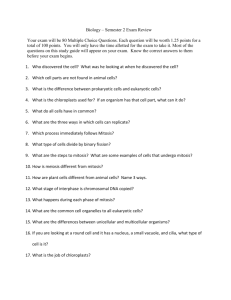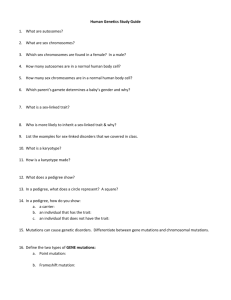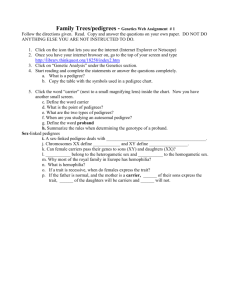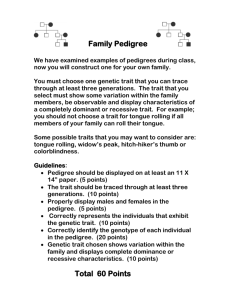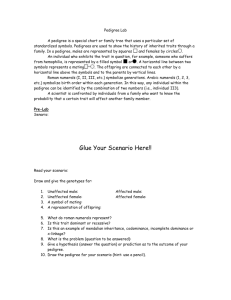Pedigree and Karyotype Acitivty
advertisement
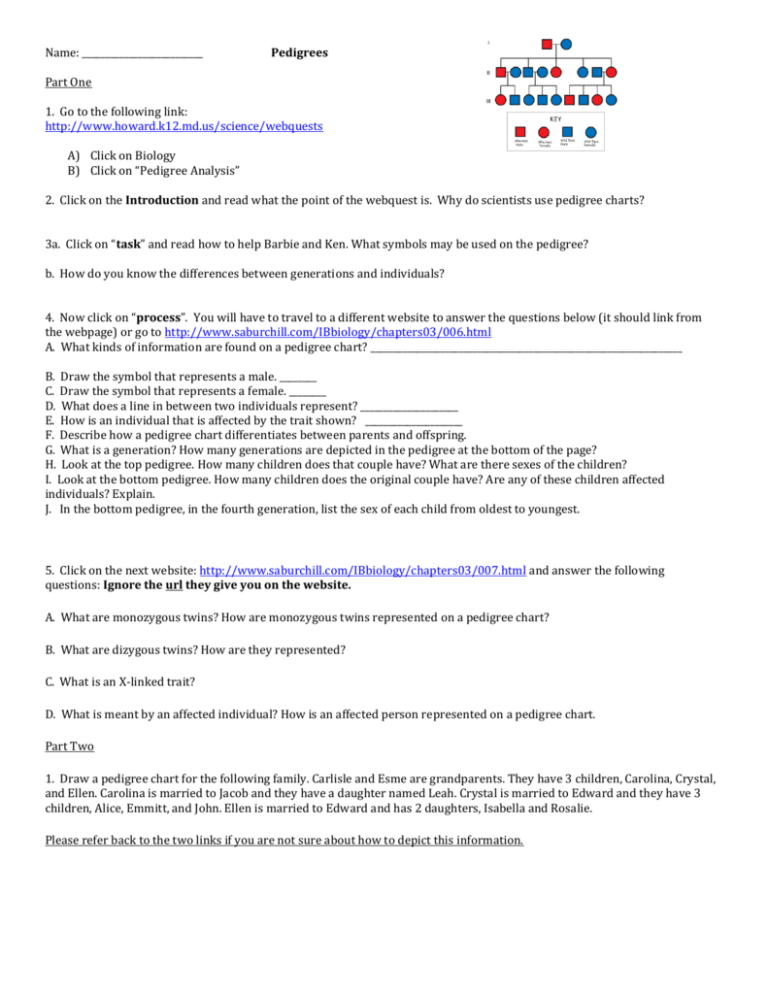
Name: __________________________ Pedigrees Part One 1. Go to the following link: http://www.howard.k12.md.us/science/webquests A) Click on Biology B) Click on “Pedigree Analysis” 2. Click on the Introduction and read what the point of the webquest is. Why do scientists use pedigree charts? 3a. Click on “task” and read how to help Barbie and Ken. What symbols may be used on the pedigree? b. How do you know the differences between generations and individuals? 4. Now click on “process”. You will have to travel to a different website to answer the questions below (it should link from the webpage) or go to http://www.saburchill.com/IBbiology/chapters03/006.html A. What kinds of information are found on a pedigree chart? ___________________________________________________________________ B. Draw the symbol that represents a male. ________ C. Draw the symbol that represents a female. ________ D. What does a line in between two individuals represent? _____________________ E. How is an individual that is affected by the trait shown? _____________________ F. Describe how a pedigree chart differentiates between parents and offspring. G. What is a generation? How many generations are depicted in the pedigree at the bottom of the page? H. Look at the top pedigree. How many children does that couple have? What are there sexes of the children? I. Look at the bottom pedigree. How many children does the original couple have? Are any of these children affected individuals? Explain. J. In the bottom pedigree, in the fourth generation, list the sex of each child from oldest to youngest. 5. Click on the next website: http://www.saburchill.com/IBbiology/chapters03/007.html and answer the following questions: Ignore the url they give you on the website. A. What are monozygous twins? How are monozygous twins represented on a pedigree chart? B. What are dizygous twins? How are they represented? C. What is an X-linked trait? D. What is meant by an affected individual? How is an affected person represented on a pedigree chart. Part Two 1. Draw a pedigree chart for the following family. Carlisle and Esme are grandparents. They have 3 children, Carolina, Crystal, and Ellen. Carolina is married to Jacob and they have a daughter named Leah. Crystal is married to Edward and they have 3 children, Alice, Emmitt, and John. Ellen is married to Edward and has 2 daughters, Isabella and Rosalie. Please refer back to the two links if you are not sure about how to depict this information. 2. Answer the following questions using the next website: http://www.ygyh.org/hemo/whatisit.htm and go to “How is it inherited”? A. How does a boy get hemophilia?_____________________ B. How does a girl become a carrier? _______________________ 3. If a woman is a carrier and the male does not have hemophilia, draw a Punnett Square and indicate the possible outcome. Part Three Now use the information that you learned about Hemophilia to complete your pedigree chart from Part Two of this lesson. Indicate that Carlisle, Ellen, John and Edward have hemophilia by shading in the symbols that represent them in the Pedigree Chart. 1. Explain in a sentence or two how hemophilia is inherited. Describe which parent gave John the defective allele for hemophilia and explain how you know. Here are a few rules of logic to help you understand the genetics behind the pedigree 1. If neither parent show the trait: a. the trait cannot be dominant. b. the trait could be recessive and either parent or both could be heterozygous carriers. 2. If one parent shows the trait: a. the trait could be dominant and the affected parent could be heterozygous while the unaffected parent is not a carrier b. the trait could be recessive and the affected parent is homozygous while the unaffected parent could be a heterozygous carrier 3. If both parents show the trait: a. the trait could be dominant and both parents could be heterozygous carriers which means that some of the children could be unaffected b. the trait could be recessive meaning that both parents would have to be homozygous and all the children would have to be affected. 1. Which members of the family above are afflicted with Huntington’s Disease? ___________________ 2. There are no carriers for Huntington’s Disease- you either have it or you don’t. With this in mind, is Huntington’s disease caused by a dominant or recessive trait? ____________________________ 3. How many children did individuals I-1 and I-2 have? _______________________________________________ 4. How many girls did II-1 and II-2 have? ______________ How many have Huntington’s Disease? ________________ 5. How are individuals III-2 and II-4 related? ________________________ I-2 and III-5? ________________________ Name: ________________________ Karyotyping Activity In this exercise you will simulate human Karyotyping using digital images from actual genetic studies. Go to http://learn.genetics.utah.edu A) Click on “Heredity and Tratis” on the left hand side of the page B) Click on “Make a Karyotype” on the right hand side of the page What is a Karyotype? How is a Karyotype constructed? Now read the directions and construct the Karyotype. Was that of a male or female? How do you know? Go back to Heredity and Traits and click on “Using Karyotypes to predict genetic disorders” What is an autosome? How many do humans have? What is a sex chromosome and how many do humans have? How do disorders come about? Click on Play and watch how normal and abnormal meiosis occurs Go to www.biology.Arizona.edu/ This will take you to the University of Arizona’s “The Biology Project” page On the left Activities column click on Karyotyping Carefully read though the Introduction, G-Banding and Your Assignment. Go to “Patient Histories” Follow the directions to complete the each of the three Karyotypes. PATIENT A: 1. Normal or abnormal Karyotype? Explain 2. Is your Karyotype that of a Male or female? 3. What notation would you use to characterize Patient A’s Karyotype? 4. What diagnosis would you give Patient A? PATIENT B: 6. Normal or abnormal karyotype? Explain 7. Is your Karyotype that of a Male or female? 8. What notation would you use to characterize Patient B’s Karyotype? 9. What diagnosis would you give Patient B? PATIENT C: 10. Normal or abnormal Karyotype? Explain 11. Is your Karyotype that of a Male or female? 12. What notation would you use to characterize Patient C’s Karyotype? 13. What diagnosis would you give Patient C?


